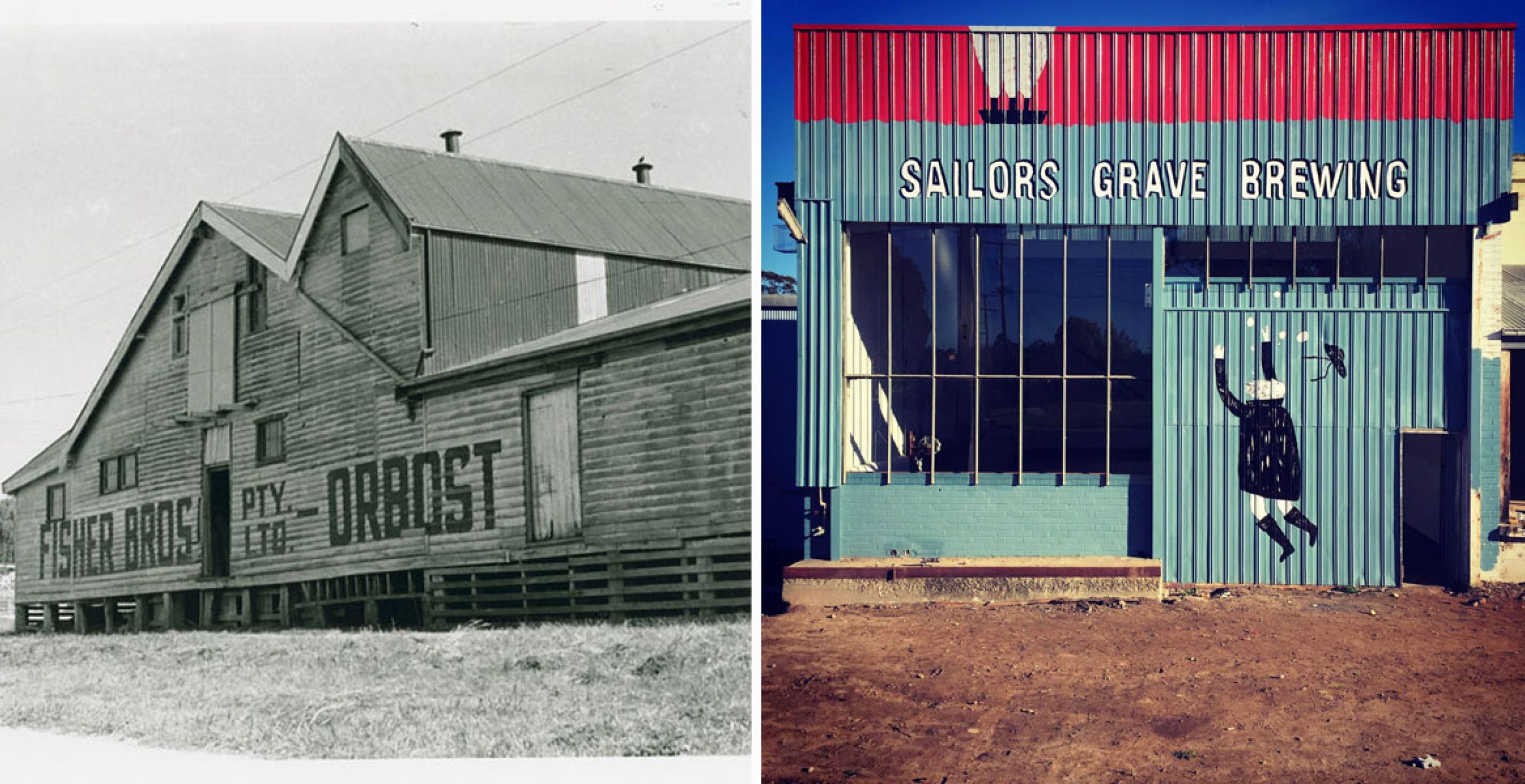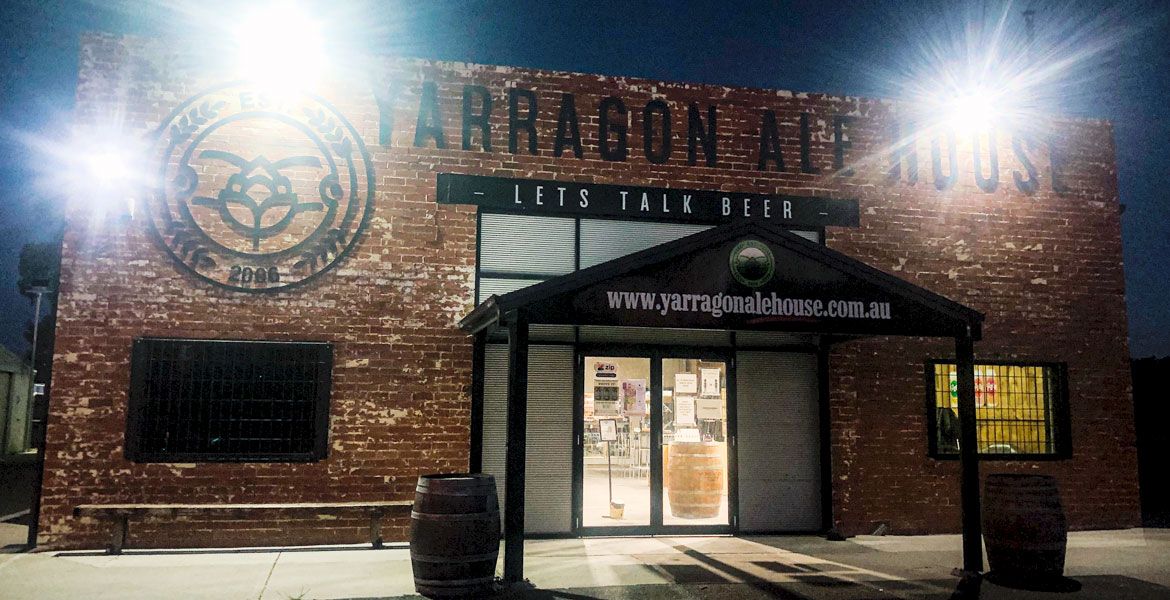Orbost is a pretty quiet place. Located more than 350 kilometres from Melbourne in East Gippsland, the town once relied heavily on the local agricultural and logging industries that have been in decline for many years. As the gateway to many of Victoria’s best national parks, today it is tourism that plays an important part in the local economy.
With these contrasting industries, it seems fitting that Orbost is the spot chosen by Chris and Gabbie Moore as the home for Sailors Grave Brewing. Having previously run a restaurant together in Darlinghurst, the couple plans to use their brewery to showcase the region and its produce. Even the name refers to a nearby beach which is said to be the resting place of those sailors who went straight into Beware Reef; if only they'd paid more attention to its name.
Although they’ve spent their recent lives in Sydney, Gabbie’s family are abalone farmers from nearby Marlo. Originally, that farm was meant to house the brewery when the couple moved to East Gippsland back in 2013.
Before starting, they embarked on a three-month long "research trip" across America in an RV, to gain whatever insights they could from the country’s craft beer scene. While many might consider three months visiting American craft breweries to be more of a dream holiday than work, Chris suggests it was an essential part of the brewery’s formation. Not only did it provide some recipe inspiration but it also showed the success regional breweries could have in attracting people to small towns.
“We went around and met lots of different brewers that we really admired,” says Chris. “So we saw all their different approaches and different styles of beers that they were doing and we came back really inspired to do what we are planning on doing now. It was easily the biggest influence on us.”

While the Moores returned to Gippsland brimming with ideas, they met one of those roadblocks that often hit new breweries: the local council. Those issues, alongside an awareness of the challenges that comes with building a new brewery from scratch made them rethink their plans.
As luck would have it they found a home relatively quickly inside the historic Orbost Butter Factory. While the building itself is expansive (well over 2,000 square metres in size) and parts are still a long way off being restored, one area was ready for its first tenants in decades.
In many ways, an old butter factory is the perfect space for a new brewery: it already has grated floors and drains, while also being designed to maintain a stable temperature. The similarities in construction are not the only reason it’s fitting that Sailors Grave has found its home in the old building. Much like what Chris and Gabbie hope to achieve with their new brewery, more than 100 years ago the factory was built to support the local industry.
The oldest parts of the Orbost butter factory date back to 1893 and were built following some of the toughest years in the town’s history. Victoria was in the midst of an economic depression that had in part been caused by the collapse in the price of land. Much of the region’s agricultural industry was left in poor shape, which was exacerbated by severe floods in 1890 and 1891, effectively cutting the town off from the rest of the world.
In 1892, the Orbost Butter and Produce Company was formed. Despite Orbost’s remoteness and small population, the company directors felt the butter factory would encourage further development in the area while also ensuring that local farmers would always have a place to supply their milk.

The energy and money invested into the project was substantial, and while it was nearly abandoned several times during the construction, in 1893 it was completed along the banks of the Snowy River. Years later, one local paper suggested the only reason the factory succeeded was because those involved simply had no idea “when they were beaten.”
While in its infancy, the factory floundered and failed to produce much, but the determination of the directors, the factory manager John Scouller, and a handful of suppliers eventually turned the operation around. Over the years it went from barely being able to supply the town, to selling its surplus to Melbourne and eventually even becoming an exporter.
The factory underwent significant expansions from 1912 to 1915 and again during the early 1930s, bringing it closer to the impressive space that it takes up today. Eventually the factory even supplied much of Orbost with its electricity.
The demise of the factory in many ways mirrors what happened to Melbourne’s breweries over the course of the 20th century. The spread of refrigeration and the increased ability for milk to be shipped long distances reduced the need for local factories so they began to amalgamate.
In turn, these amalgamations gave way to takeovers and ultimately the factory became part of the dairy industry behemoth that is Murray Goulburn. By 1974, the building no longer served any purpose, the equipment was removed, and it was left to fall into a state of decay: a good place for local teenagers to practise their graffiti skills, but not much else.
That was until 2010 when the site was bought by its current owners who saw an opportunity for a grand old building to be restored. Since then, they have used whatever spare time they’ve had to try and restore the building to its former glory – a job made all the more difficult with no remnants of the building’s plans available, thus making it hard to know which walls were full of asbestos and which were full of electrical wiring.

The energy and time that has been put into the building suggests they might just have been another group that had no idea when they were beaten. Or, as one of the owners suggested, they were probably the only people stupid enough to go anywhere near it. Aside from the part now inhabited by Sailors Grave, six years in and they are still some time off restoring the building.
That brings us back to the present day where the Moores hope that their brewery can have a similar effect on the town as their historical predecessor. To achieve this, they plan on involving as many local producers in their beer as they can.
“It’s really hard to be truly local when you are a brewery,” says Chris. “You can often be very close to your customer but quite remote from your ingredients. It’s a small community where we are and it’s a rural community and there are lots of dying industries.
“We really want to involve the people around here as much as possible in growing ingredients and being involved in the ideas of our brewery. It’s all about opening up conversations with people.”
Sailors Grave’s beers make this point clear; their core range includes a gose (the superbly named Down She Gose) made with local seaweed supplied by a nearby farmer who specialises in sea vegetables. The attention this has attracted from other locals has been impressive, even if plenty of people in the area had never heard of a gose. For Chris and Gabbie it’s a way to encourage new converts to the world of craft beer.
“When it comes to the actual beer, people say they like their VB and their Carlton,” Chris says. “But as soon as you start involving them in the process they get excited on a different level; it’s a way into the community. While people might turn up their noses at anything too interesting in beer they become excited in the project regardless.”
Other than the gose, the rest of the core range currently includes an altbier (Southern Rights Ale) and a "sessionable" East Coast US style IPA (Drowned Man IPA). Seasonals will also be regularly brewed and the initial offerings include the likes of a Mandarin Berliner Weisse and a White Stout made with sea urchins (both featuring locally harvested ingredients of course).
If all goes to plan, Sailors Grave Brewing may show how history can sometimes rhyme. In its heyday the Orbost Butter Factory received milk from more than 100 different local suppliers and was one of the major employers in the region. The population of Orbost has been declining for some time, and Chris and Gabbie don’t only want the brewery to be a success, but for the town to share in that success too.
“We would love to be the grit in the oyster [of Orbost] where shit builds around us,” says Chris. “We would love to involve people in as many ways as we can. We want to grow, and employ people and we always want things to collaborate on.”
Sailors Grave Brewing’s beers will be making their way across Melbourne in early to mid-September.
Photo top left: Old butter factory, Orbost. 1963. Centre of Gippsland studies Collection, reproduced courtesy Federation University Australia.

















